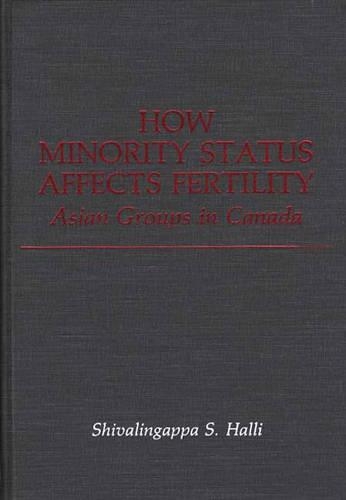
How Minority Status Affects Fertility: Asian Groups in Canada
(Hardback)
Publishing Details
How Minority Status Affects Fertility: Asian Groups in Canada
By (Author) Shiva S. Halli
Bloomsbury Publishing PLC
Praeger Publishers Inc
11th June 1987
United States
Classifications
Tertiary Education
Non Fiction
Population and demography
304.632
Physical Properties
Hardback
216
Description
The history of Asian immigrants in Canada is more than a century old, and the number of persons of Asian descent has more than doubled over the past fifteen years, yet until now there has been no systematic study of these Asian-born Canadians. Using specifically obtained demographic data from Statistics Canada, Shiva S. Halli has investigated differences in family size among Asian ethnic groups in Canada in order to examine inter-group differences and to pinpoint causes for such variations. The author examines the context of fertility differentials by looking at social, cultural, and historical backgrounds, and attempts to utilize the minority status hypothesis, which was originally applied to ethnic groups in the United States, to explain differences in Asian ethnic fertility in Canada.
Reviews
Sociologist-demographer Halli examines fertility differentials between Chinese, Japanese, and East Indians, using special unpublished cross-tabulations from the 1971 Canada census as well as analyses of individual records from the 1/100 PUS sample file. Halli begins with an overview of the perspective of minority group status as it applies to the fertility of Asian ethnics. Chapters 2 and 3 review historical trends in Asian immigration, and document fertility differentials among Asian ethnic groups. In Chapter 4, he systematically reevaluates the logical and empirical strengths of the social characteristics/assimilationist perspectives as opposed to minority group status hypothesis, and offers a reconceptualization of the latter. Halli then tests the reconceptualized version, using the fertility experiences of the Chinese and Japanese. The value of the study is in its theoretical analysis and its competent use of various demographic indexes. Well written; good bibliography. A must for students of ethnicity and race, and population studies. College and university libraries.-Choice
"Sociologist-demographer Halli examines fertility differentials between Chinese, Japanese, and East Indians, using special unpublished cross-tabulations from the 1971 Canada census as well as analyses of individual records from the 1/100 PUS sample file. Halli begins with an overview of the perspective of minority group status as it applies to the fertility of Asian ethnics. Chapters 2 and 3 review historical trends in Asian immigration, and document fertility differentials among Asian ethnic groups. In Chapter 4, he systematically reevaluates the logical and empirical strengths of the social characteristics/assimilationist perspectives as opposed to minority group status hypothesis, and offers a reconceptualization of the latter. Halli then tests the reconceptualized version, using the fertility experiences of the Chinese and Japanese. The value of the study is in its theoretical analysis and its competent use of various demographic indexes. Well written; good bibliography. A must for students of ethnicity and race, and population studies. College and university libraries."-Choice
Author Bio
SHIVALINGAPPA S. HALLI is Assistant Professor of Sociology at the University of Manitoba, Winnipeg, Canada.
